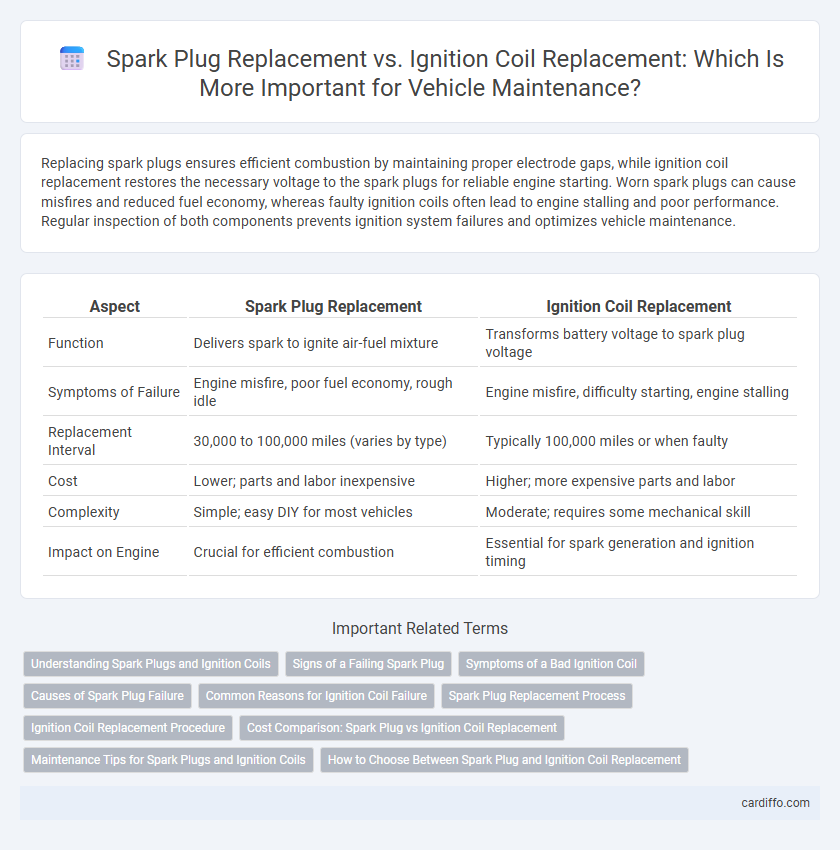Replacing spark plugs ensures efficient combustion by maintaining proper electrode gaps, while ignition coil replacement restores the necessary voltage to the spark plugs for reliable engine starting. Worn spark plugs can cause misfires and reduced fuel economy, whereas faulty ignition coils often lead to engine stalling and poor performance. Regular inspection of both components prevents ignition system failures and optimizes vehicle maintenance.
Table of Comparison
| Aspect | Spark Plug Replacement | Ignition Coil Replacement |
|---|---|---|
| Function | Delivers spark to ignite air-fuel mixture | Transforms battery voltage to spark plug voltage |
| Symptoms of Failure | Engine misfire, poor fuel economy, rough idle | Engine misfire, difficulty starting, engine stalling |
| Replacement Interval | 30,000 to 100,000 miles (varies by type) | Typically 100,000 miles or when faulty |
| Cost | Lower; parts and labor inexpensive | Higher; more expensive parts and labor |
| Complexity | Simple; easy DIY for most vehicles | Moderate; requires some mechanical skill |
| Impact on Engine | Crucial for efficient combustion | Essential for spark generation and ignition timing |
Understanding Spark Plugs and Ignition Coils
Spark plugs deliver the electrical spark needed to ignite the air-fuel mixture in the engine's combustion chamber, while ignition coils transform the battery's voltage to the high voltage required by spark plugs. Proper maintenance of spark plugs ensures consistent engine performance and fuel efficiency, whereas faulty ignition coils can lead to misfires and engine stalling. Understanding the distinct roles and condition of both components is crucial for accurate diagnosis and effective maintenance in ignition systems.
Signs of a Failing Spark Plug
Signs of a failing spark plug include engine misfires, rough idling, and reduced fuel efficiency. Spark plugs that exhibit worn electrodes, heavy carbon deposits, or cracks can significantly impair ignition performance. Replacing spark plugs on schedule prevents ignition coil strain and maintains optimal engine operation.
Symptoms of a Bad Ignition Coil
Symptoms of a bad ignition coil include engine misfires, rough idling, reduced fuel efficiency, and difficulty starting the vehicle. Unlike spark plug replacement, which primarily addresses wear and fouling, ignition coil replacement targets electrical failures that disrupt the spark generation process. Identifying these symptoms early ensures proper maintenance and prevents further engine damage.
Causes of Spark Plug Failure
Spark plug failure is primarily caused by carbon fouling, overheating, and electrode wear, which degrade ignition performance and fuel efficiency. Ignition coil failure, contrastingly, stems from electrical issues such as coil insulation breakdown or overheating, leading to misfires and engine stalling. Understanding these distinct causes is critical for targeted maintenance and prolonging engine lifespan.
Common Reasons for Ignition Coil Failure
Ignition coil failure often results from excessive heat, electrical overload, and wear over time, causing misfires and poor engine performance. Unlike spark plug replacement, which addresses electrode wear, ignition coil replacement targets faults in the coil windings or insulation breakdown. Regular maintenance and timely replacement of ignition coils prevent further engine damage and maintain optimal ignition system efficiency.
Spark Plug Replacement Process
Spark plug replacement involves removing the old spark plugs using a spark plug socket and ratchet, inspecting the ignition system for wear or damage, and installing new spark plugs with the correct gap measurement to ensure optimal engine performance. This process improves combustion efficiency by providing a consistent spark, reducing misfires and fuel consumption. Maintaining properly functioning spark plugs extends engine life and enhances fuel economy compared to ignition coil replacement, which primarily addresses coil failure rather than combustion quality.
Ignition Coil Replacement Procedure
Ignition coil replacement requires disconnecting the battery, removing the engine cover, and unplugging the faulty ignition coil from the spark plug and wiring harness. After detaching the coil mounting bolts, carefully extract the defective coil and install a new one, ensuring proper seating and secure connection to avoid misfires. Testing the new coil's voltage output and engine performance confirms the success of the replacement procedure.
Cost Comparison: Spark Plug vs Ignition Coil Replacement
Spark plug replacement typically costs between $50 and $150, depending on the vehicle make and labor rates, while ignition coil replacement ranges from $150 to $300 due to higher part expenses and more complex installation. The price difference is attributed to ignition coils being more expensive components and requiring increased labor time. Regular spark plug maintenance can prevent ignition coil damage, potentially reducing overall repair costs.
Maintenance Tips for Spark Plugs and Ignition Coils
Regular inspection and timely replacement of spark plugs ensure optimal engine performance and fuel efficiency by preventing misfires and ignition issues. Ignition coils should be checked for signs of wear, such as cracks or corrosion, to avoid engine stalling and poor acceleration. Using manufacturer-recommended parts and maintaining a consistent replacement schedule based on mileage significantly enhances the longevity of both spark plugs and ignition coils.
How to Choose Between Spark Plug and Ignition Coil Replacement
Choosing between spark plug replacement and ignition coil replacement depends on diagnosing the root cause of ignition problems. Spark plugs wear out periodically, causing misfires, poor fuel economy, and rough idling, while ignition coils degrade electrically and mechanically, leading to weak or no spark output. Conducting a thorough inspection, including resistance testing of coils and visual spark plug analysis, helps determine whether to replace the spark plugs, the ignition coils, or both for optimal engine performance.
Spark Plug Replacement vs Ignition Coil Replacement Infographic

 cardiffo.com
cardiffo.com